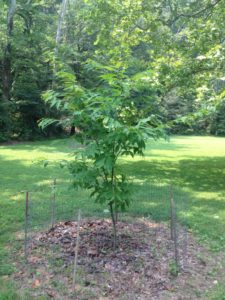
Prior to the 1900s, the American chestnut tree once dominated over 200 million acres of the eastern hardwood forest from Maine to Georgia, and west to the Ohio River Valley. Researchers have estimated that 1 out of every 4 trees in the Appalachian Mountains was an American chestnut. The American chestnut lumber was highly prized for its rot-resistance and ease to work. The wood was used to make homes, barns, furniture, railroad ties, fence posts, and musical instruments. The nuts from the tree were one of the single most important food sources for a wide variety of wildlife, such as black bear, deer, turkey, squirrel, and birds. This tree was also a prolific food source for humans and livestock. In the early 1900s a fungal disease known as Cryphonectria parasitica (Chestnut Blight) was accidentally brought into the United States on imported plant material. It also was estimated by the 1950s that the blight had killed 4 billion chestnut trees. By the 1960s the American chestnut was practically extinct throughout most of its native range.
Bernheim’s efforts to restore the American chestnut first started in 1989 by Bernheim Chief Horticulturist, Buddy Hubbuch. Buddy obtained 21 seedlings from the Kentucky Division of Forestry and grew these trees in Bernheim’s nursery until 1991. In 1991 these trees were out planted in the Guerilla Hollow and Tom’s Town Picnic Areas.
In May of 1996, Bernheim Research Director Dr. Varley Wiedeman obtained 200 American chestnut seeds from the The American Chestnut Foundation. Dr Wiedeman, along with Bernheim staff, out planted these seeds in our Research Forest in the Rice Orchard Ridge and Ashlock Areas.
In 2002, Dr. Chuck Rhoades from the University of Kentucky Department of Forestry and Bernheim Natural Areas staff out planted additional chestnut trees in the forest at Bernheim. Dr. Rhoades’ research objectives were to find out if the American chestnut would survive when planted in a existing forest habitat under fast growing succession trees and if they would be able to tolerate deer grazing.
From 2004 until present day, Bernheim has continued to out plant both pure and hybrid chestnuts for research studies. We continue to work with The American Chestnut Foundation and the American Chestnut Cooperators’ Foundation on restoring the American chestnut to its former place in the hardwood forest of America.
Bernheim currently has 13 pure and 14 hybrid American chestnut trees out planted in the following locations: The Arboretum, Sugar Tree Picnic Area, No Name Picnic Area between Cull and Jackson Hollow Picnic Areas, and Pines Picnic Areas.
The American chestnut tree that is planted in the Pines Picnic Area is the oldest living tree in the research project at this time. This tree was accession in the year 2005.
Want more Vanishing Acts? Click here to view the archive.
Vanishing Acts: Trees Under Threat was developed and produced by The Morton Arboretum in association with the Global Trees Campaign, a partnership between Fauna and Flora International and Botanic Gardens Conservation International.
Funding for this exhibit comes from The Morton Arboretum and the U.S. Institute for Museum and Library Services, Museums for America Grant Program.
Support locally comes from LG&E and KU. Additional support provided by Shepherdsville/Bullitt County Tourism.

